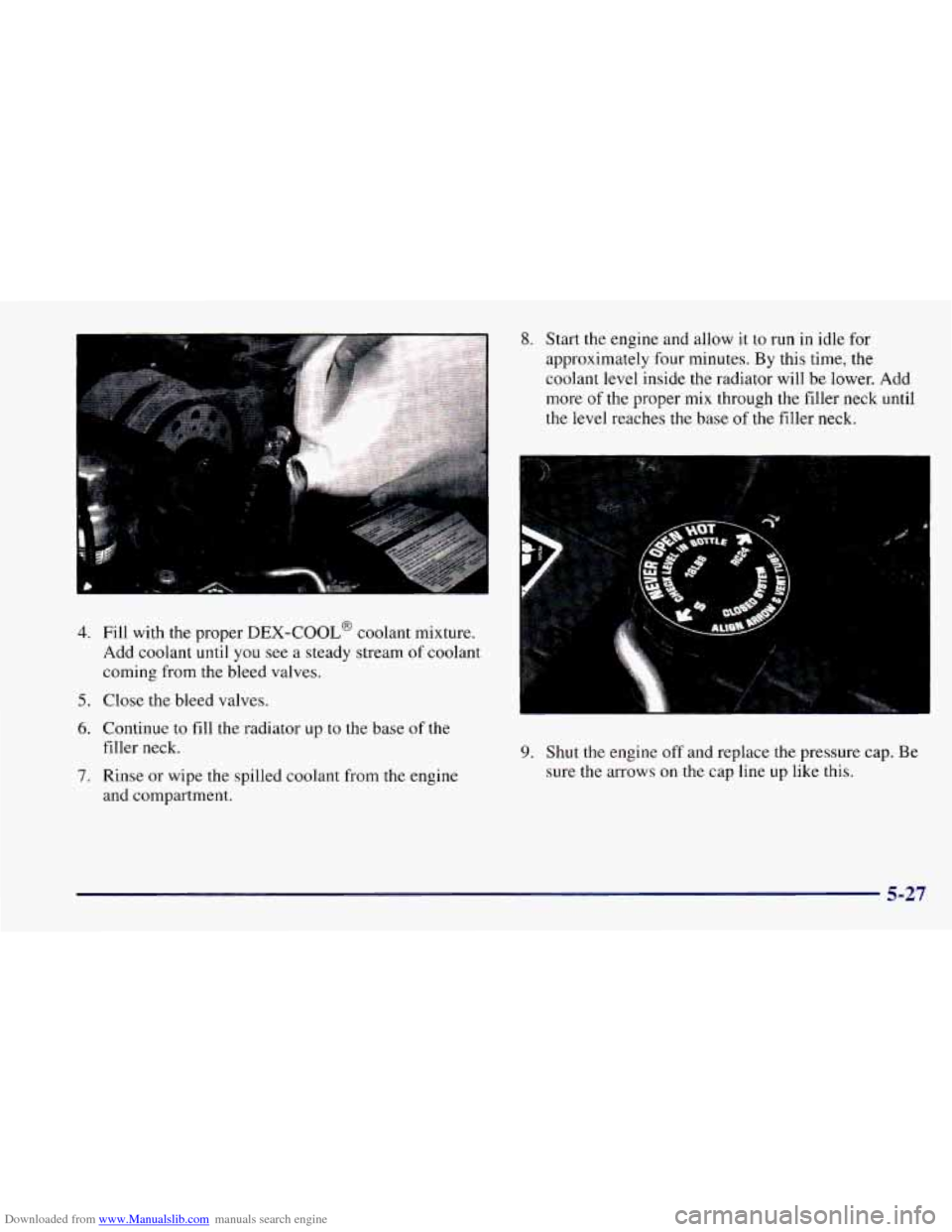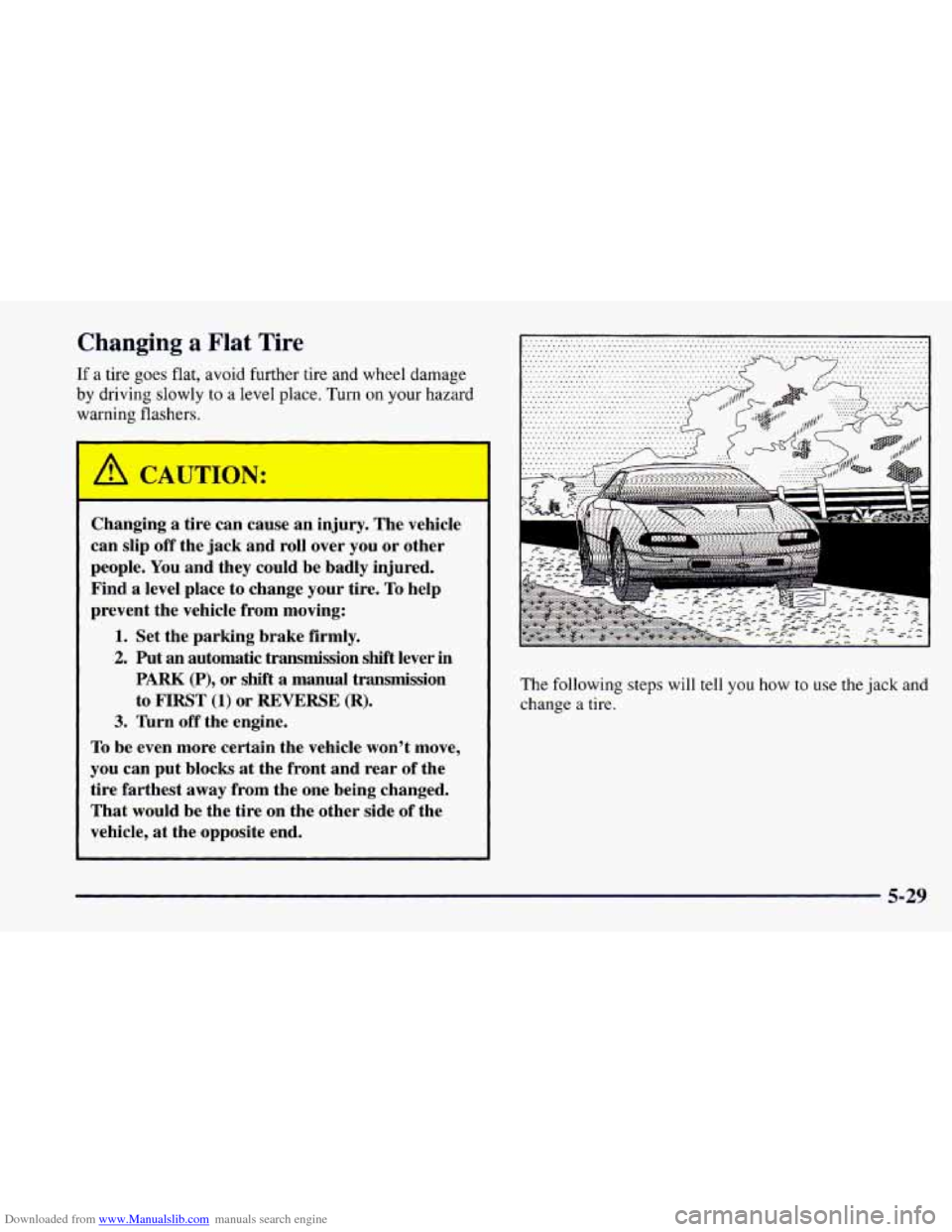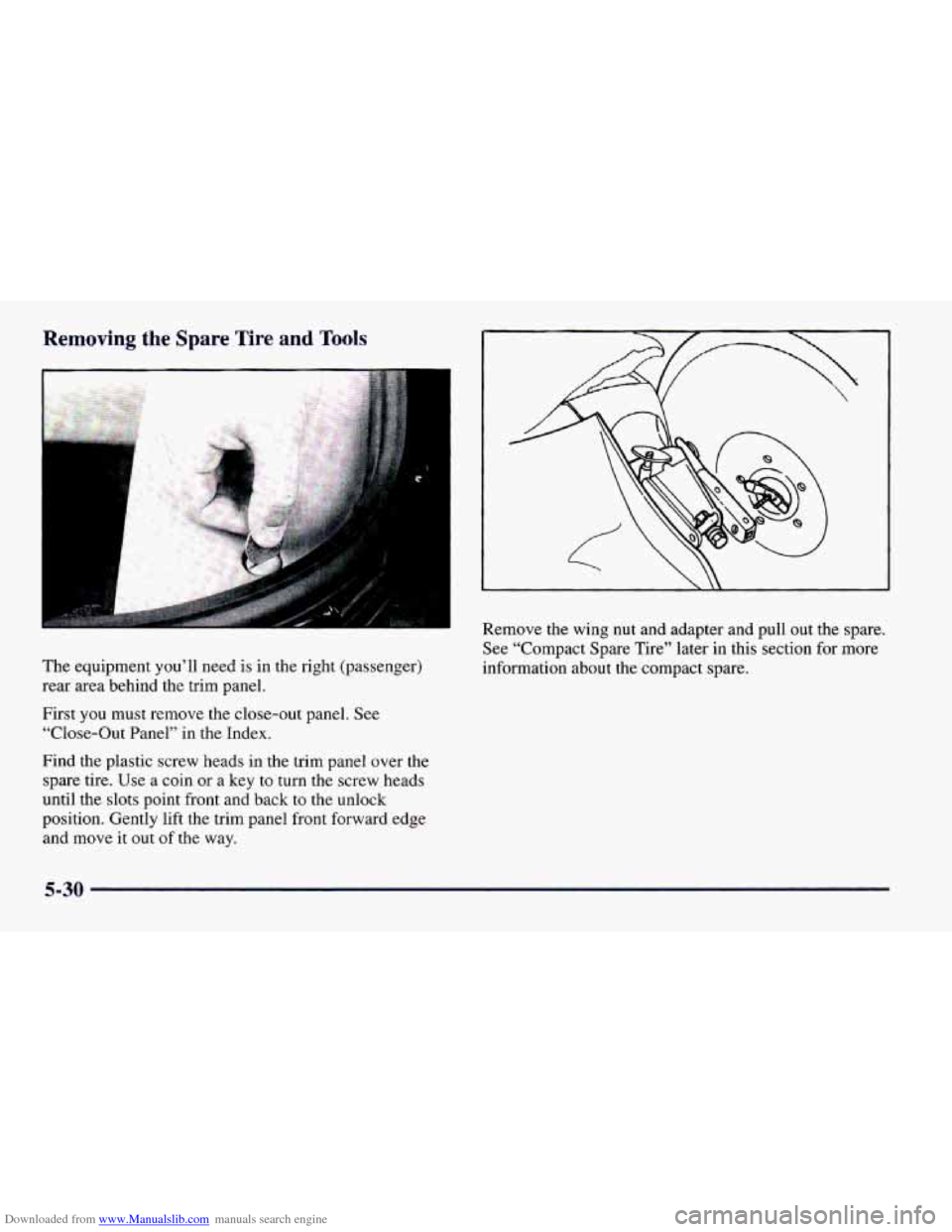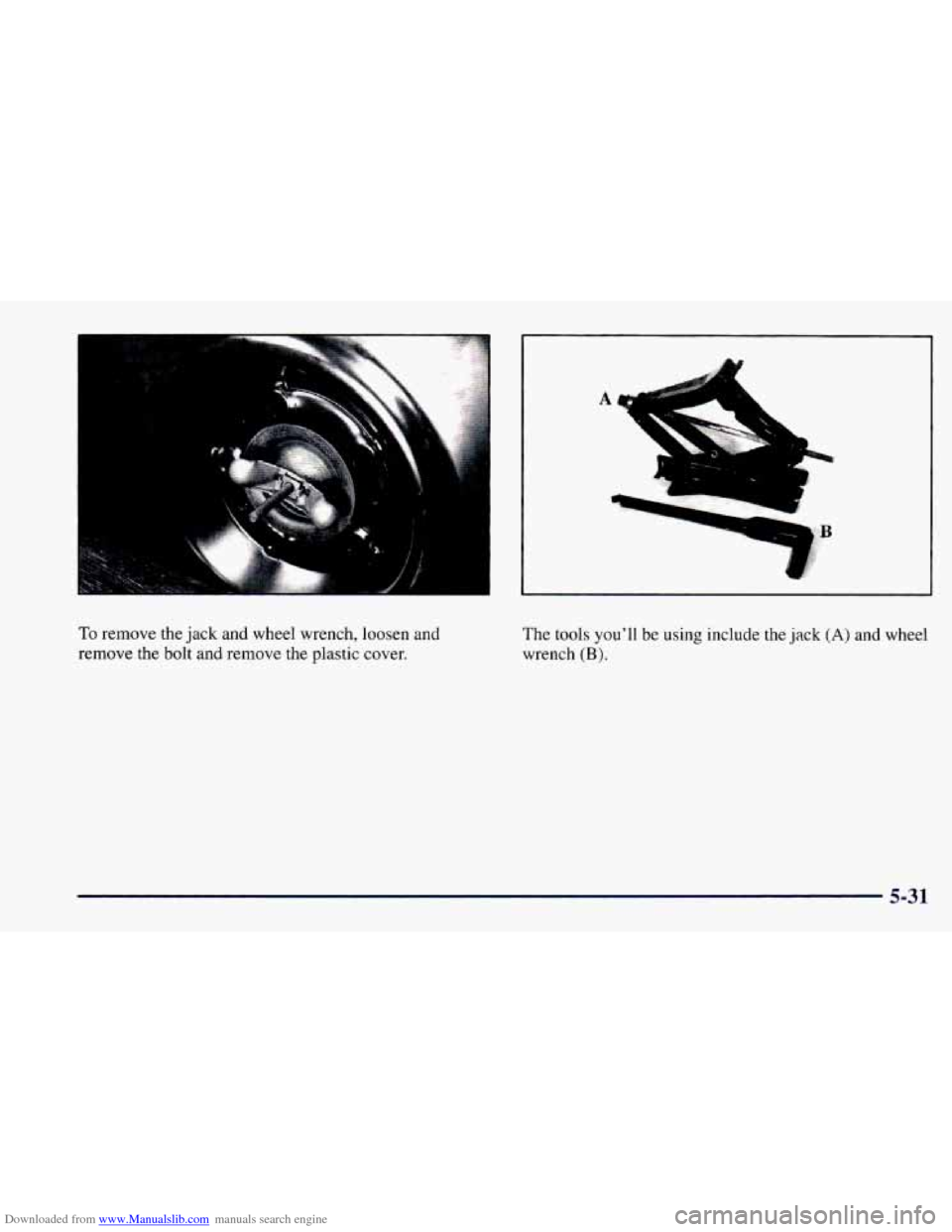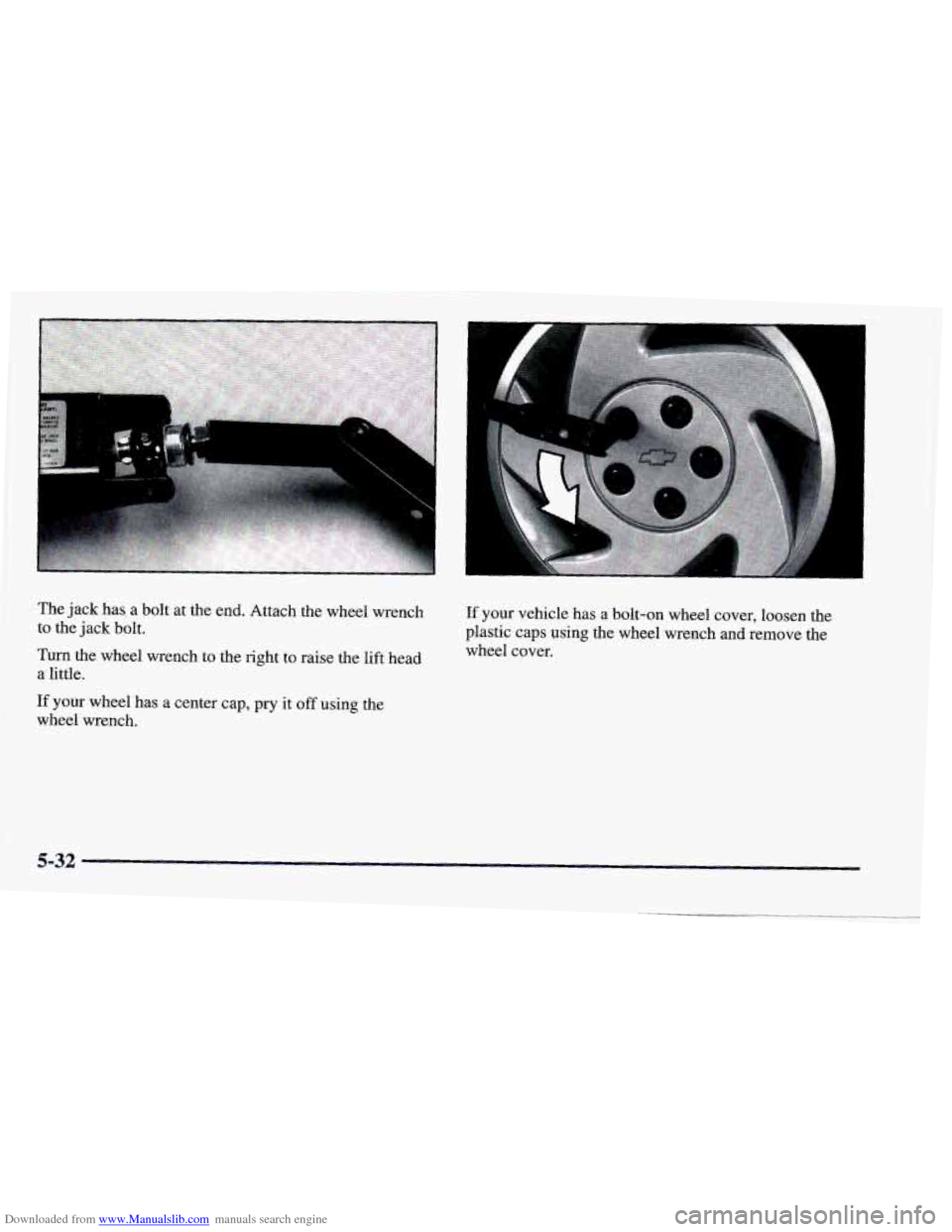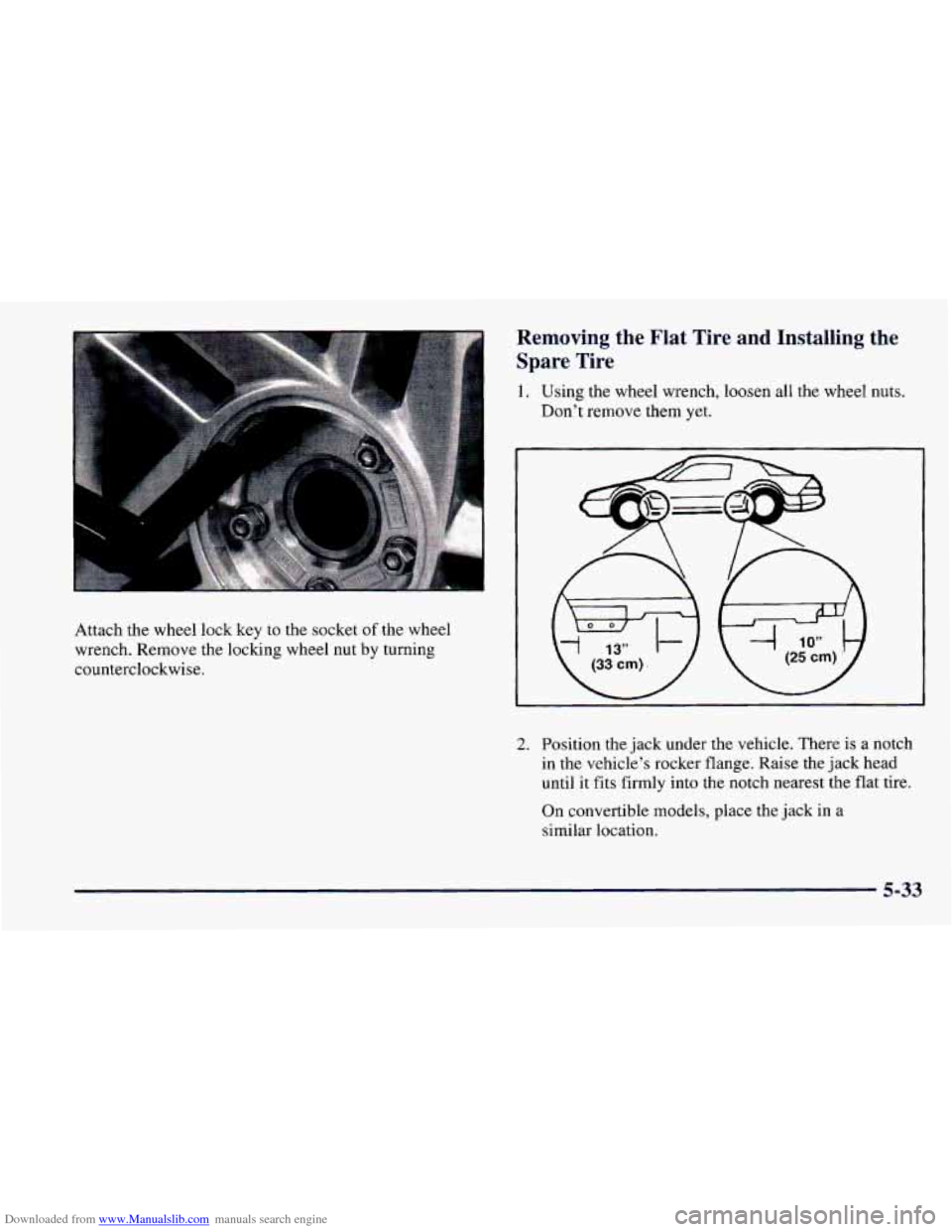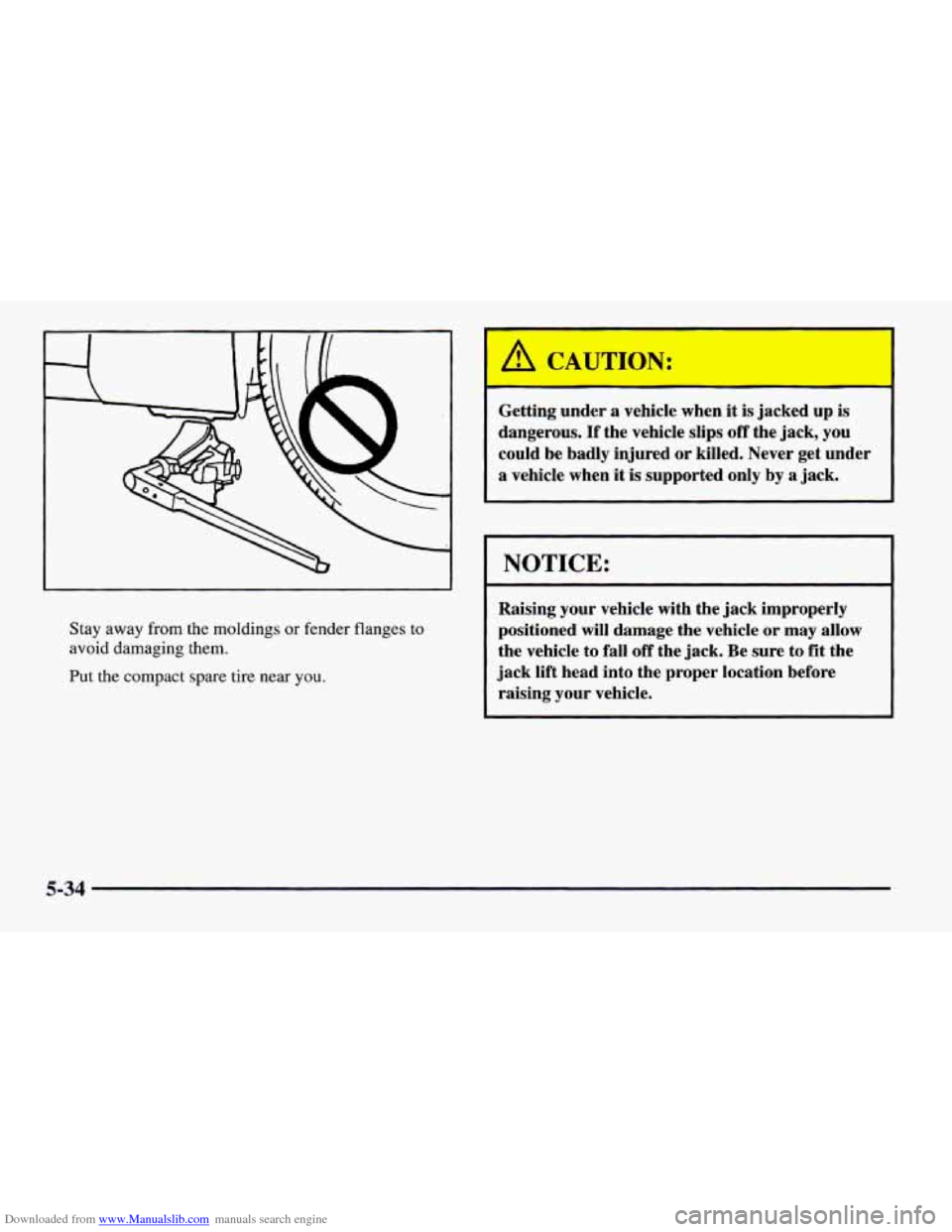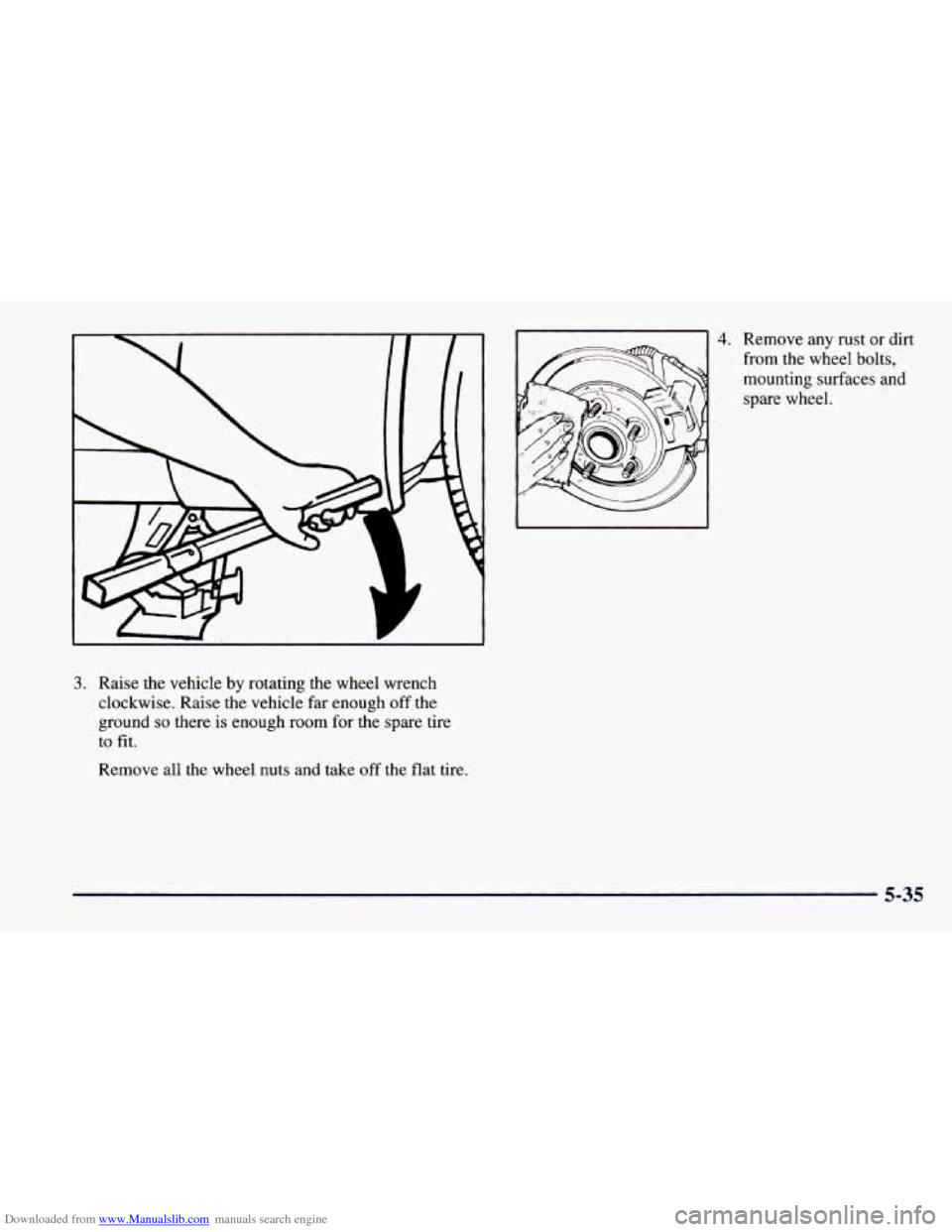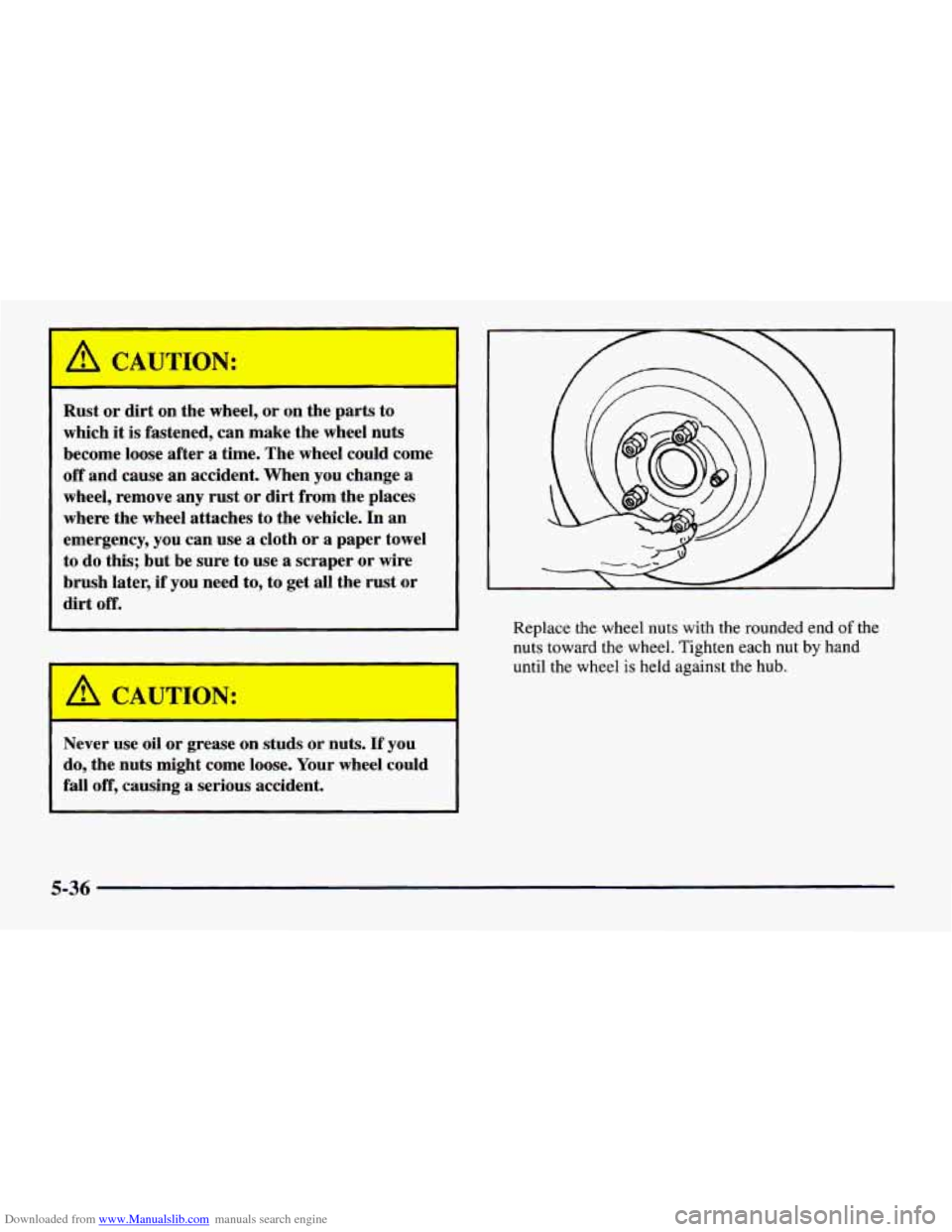CHEVROLET CAMARO 1997 4.G Owners Manual
CAMARO 1997 4.G
CHEVROLET
CHEVROLET
https://www.carmanualsonline.info/img/24/8066/w960_8066-0.png
CHEVROLET CAMARO 1997 4.G Owners Manual
Trending: park assist, glove box, parking brake, seat adjustment, night vision, child lock, load capacity
Page 231 of 404
Downloaded from www.Manualslib.com manuals search engine 8. Start the engine and allow it to run in idle for
approximately four minutes. By this time, the
coolant level inside the radiator will be lower. Add
more
of the proper mix through the filler neck until
the level reaches the base of the filler neck.
4. Fill with the proper DEX-COOL@ coolant mixture.
Add coolant until
you see a steady stream of coolant
coming from
the bleed valves.
5. Close the bleed valves.
I
E
6. Continue to fill the radiator up to the base of the
filler neck.
7. Rinse or wipe the spilled coolant from the engine
and compartment.
9. Shut the engine off and replace the pressure cap. Be
sure the arrows on the cap line up like this.
5-27
Page 232 of 404
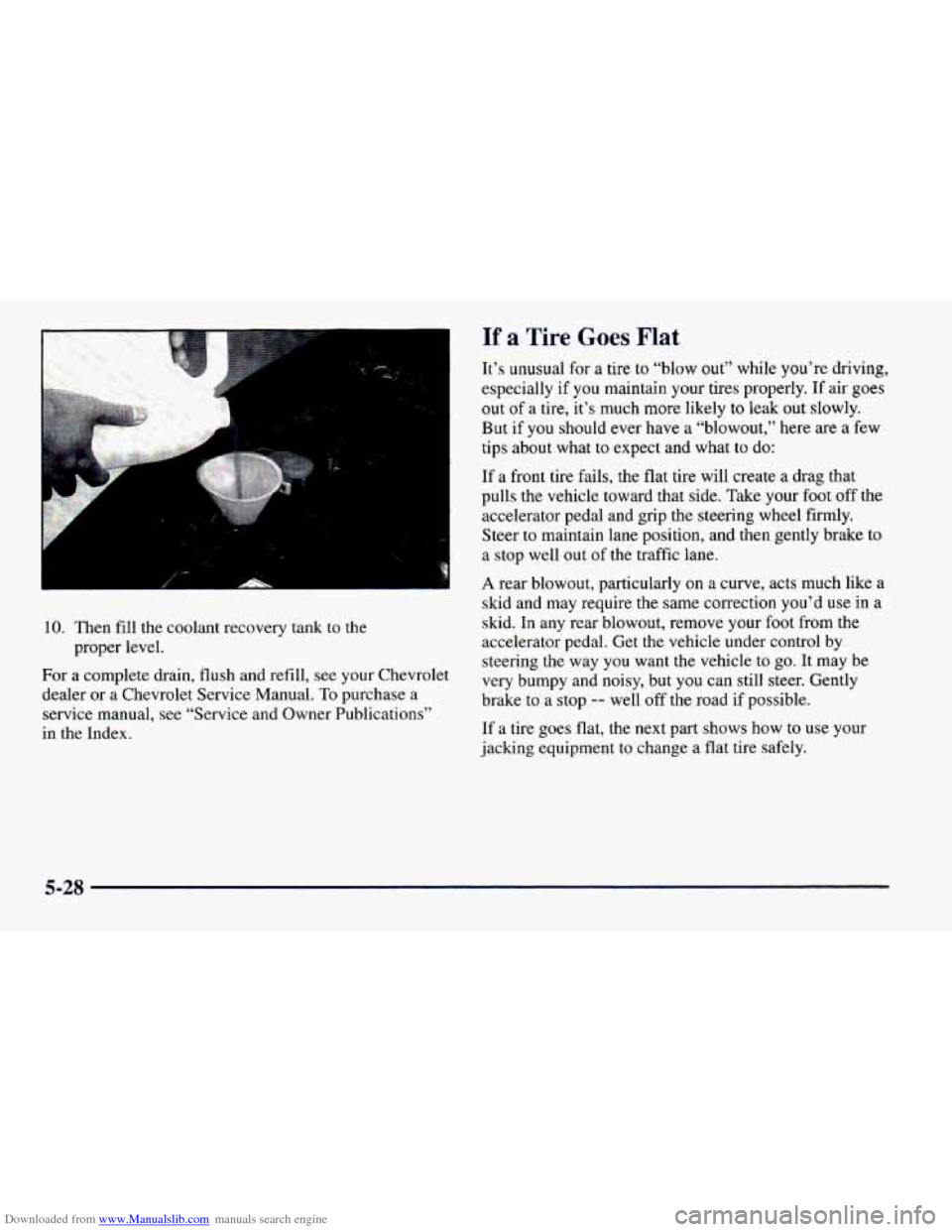
Downloaded from www.Manualslib.com manuals search engine 10. Then fill the coolant recovery tank to the
For a complete drain, flush and refill,
see your Chevrolet
dealer or a Chevrolet Service Manual.
To purchase a
service manual, see “Service and Owner Publications”
in the Index. proper
level.
If a Tire Goes Flat
It’s unusual for a tire to “blow out” while you’re driving,
especially if you maintain
your tires properly. If air goes
out of a tire, it’s much more likely to leak out slowly.
But if you should ever have a “blowout,” here
are a few
tips about what to expect and what to do:
If a front tire fails, the flat tire will create
a drag that
pulls the vehicle toward that side. Take your foot off the
accelerator pedal and grip the steering wheel firmly.
Steer to maintain lane position, and then gently brake to
a stop well
out of the traffic lane.
A rear blowout, particularly on a curve, acts much like a
skid and may require the same correction you’d
use in a
skid. In any rear blowout, remove your foot from the
accelerator pedal. Get the vehicle under control by
steering the way you want the vehicle to
go. It may be
very bumpy and noisy, but you can still steer. Gently
brake to a stop
-- well off the road if possible.
If a tire goes flat, the next part shows how to use your
jacking equipment to change a flat tire safely.
5-28
Page 233 of 404
Downloaded from www.Manualslib.com manuals search engine Changing a Flat Tire
If a tire goes flat, avoid further tire and wheel damage
by driving slowly to a level place. Turn on your hazard
warning flashers.
-
/ CA, TION:
Changing a tire can cause an injury. The vehicle
can slip off the jack and roll over you or other
people. You and they could be badly injured.
Find
a level place to change your tire. To help
prevent the vehicle from moving:
1. Set the parking brake firmly.
2. Put an automatic transmission shift lever in
PARK (P), or shift
a manual transmission
to FIRST
(1) or REVERSE (R).
3. nrn off the engine.
To be even more certain the vehicle won’t move,
you can put blocks at the front and rear
of the
tire farthest away from the one being changed.
That would be the tire on the other side of the
vehicle, at the opposite end.
The following steps will tell you how to use the jack and
change
a tire.
5-29
Page 234 of 404
Downloaded from www.Manualslib.com manuals search engine Removing the Spare Tire and Tools
1
The equipment you’ll need is in the right (passenger)
rear area behind the trim panel.
First
you must remove the close-out panel. See
“Close-Out Panel” in the Index.
Find the plastic screw heads in the trim panel over the
spare tire. Use a coin or a key
to turn the screw heads
until the slots point front and back to the unlock
position. Gently lift the trim panel front forward edge
and move it
out of the way. Remove the wing nut and
adapter and pull out the spare.
See “Compact Spare Tire” later in this section for more
information about the compact spare.
5-30
Page 235 of 404
Downloaded from www.Manualslib.com manuals search engine A
- j.
*
To remove the jack and wheel wrench, loosen and
remove the
bolt and remove the plastic cover. The
tools
you'll be using include the jack (A) and wheel
wrench
(B).
5-31
Page 236 of 404
Downloaded from www.Manualslib.com manuals search engine I
The jack has a bolt at the end. Attach the wheel wrench
to the jack bolt.
Turn the wheel wrench to the right to raise the lift head
a little.
If your wheel has a center cap, pry it off using the
wheel wrench.
If your vehicle has a bolt-on wheel cover, loosen the
plastic caps using the wheel wrench and remove the
wheel cover.
5-32
Page 237 of 404
Downloaded from www.Manualslib.com manuals search engine Removing the Flat Tire and Installing the Spare Tire
1. Using the wheel wrench, loosen all the wheel nuts.
Don’t remove them
yet.
Attach the wheel lock key to the socket of the wheel
wrench. Remove the locking wheel
nut by turning
counterclockwise.
2. Position the jack under the vehicle. There is a notch
in the vehicle’s rocker flange. Raise the jack head
until it fits firmly into the notch nearest the flat tire.
On convertible models, place the jack in a
similar location.
5-33
Page 238 of 404
Downloaded from www.Manualslib.com manuals search engine Stay away from the moldings or fender flanges to
avoid damaging them.
Put the compact spare tire near
you.
Getting under a vehicle when .s jacl I up is
dangerous. If the vehicle slips off the jack, you
could be badly injured or killed. Never get under
a vehicle when it is supported only by a jack.
1
I NOTICE:
Raising your vehicle with the jack improperly
positioned
will damage the vehicle or may allow
the vehicle to fall
off the jack. Be sure to fit the
jack lift head into the proper location before
raising your vehicle.
5-34
Page 239 of 404
Downloaded from www.Manualslib.com manuals search engine 4. Remove any rust or dirt
from the wheel bolts,
mounting surfaces and
spare wheel.
3. Raise the vehicle by rotating the wheel wrench
clockwise. Raise
the vehicle far enough off the
ground
so there is enough room for the spare tire
to fit.
Remove all the wheel nuts and take off the flat tire.
5-35
Page 240 of 404
Downloaded from www.Manualslib.com manuals search engine A Ck 'JTION:
-
Rust or dirt on the wheel, or on the parts to
which
it is fastened, can make the wheel nuts
become loose after
a time. The wheel could come
off and cause an accident. When you change a
wheel, remove any rust or dirt from the places
where the wheel attaches to the vehicle. In an
emergency, you can use
a cloth or a paper towel
to do this; but be sure to use a scraper or wire
brush later, if you need to, to get all the rust
or
dirt off.
I
-
A CAUTION:
Never use oil or grease on studs or nuts. If you
do, the nuts might come loose. Your wheel could
fall
off, causing a serious accident.
Replace the wheel nuts with the rounded end of the
nuts toward the wheel. Tighten each
nut by hand
until the
wheel is held against the hub.
5-36
Trending: boot, inflation pressure, heater, remove seats, air suspension, ignition, warning lights
